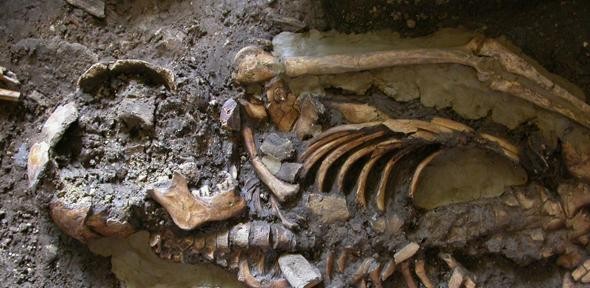'Fourth Strand' of Ancient European Ancestry Discovered
| Ana Verayo | | Nov 17, 2015 06:30 AM EST |
(Photo : Eppie Jones/University of Cambridge) DNA was extracted from the molar teeth of this skeleton, dating from almost 10,000 years ago and found in the Kotias Klde rockshelter in Western Georgia.
Scientists who are studying the genetic makeup of modern Europeans reveal how there was an ancient tribe that contributed to a "fourth strand" of European ancestry.
Researchers believe that the three major ancestral populations that make up Europe are the indigenous hunters, farmers from the Middle East and a migratory population from the Bronze Age hailing from the east, will now be joined by another ancient group of people.
Like Us on Facebook
This new evidence was taken from DNA discovered from the Caucasus Mountains near the border between Russia and Georgia, where this tiny yet crucial part of the European genome apparently originates from a unique population of hunter gatherers who survived the Ice Age by taking shelter for 7,000 years in these mountains.
When the Ice Age died down some 22,000 years ago, these Caucasus people started to co-exist with horse riding herders of Eastern Europe's steppe lands, where they are more known as the Yamnaya culture, according to the researchers.
This ancient culture also spread across western Europe some 5,000 years back, where they also joined with the other early ancestral populations of the indigenous hunter gatherers who were already thriving in Europe some 40,000 years ago, along with the Middle Eastern farming groups that migrated into the region some 7,000 years back.
The Yamnaya culture brought about metallurgical and herding skills of the Bronze Age where this ancient Caucasus DNA was detected in almost all populations in Europe, according to the team.
According to Andrea Manica from the University of Cambridge, the origins of the Yamnaya culture has always been a mystery up until now, including their DNA history. He adds that with this new evidence, this genetic makeup of Eastern European hunter gatherers along with the Caucasus hunter gatherers were the last human population who survived the last ice age in an isolated region.
This new study reveals that this Caucasus pocket is now the fourth major strand that composes ancient European ancestry, which was previously unknown before.
This Caucasus DNA was recovered from two burial grounds from Georgia where the specimens are both 13,000 and 10,000 years old respectively. This new study is published in the journal, Nature Communications.
Tags'Fourth Strand' of Ancient European Ancestry Discovered, new DNA ancient european ancestry, fourth european tribe ancestry, fourth ancestral tribe europe, european lineage ancestry DNA, fourth strand european ancestry, genome study, genetic makeup europeans, fourth strand europe, caucasus strand, yamnaya culture, caucasus DNA
©2015 Chinatopix All rights reserved. Do not reproduce without permission
EDITOR'S PICKS
-

Did the Trump administration just announce plans for a trade war with ‘hostile’ China and Russia?
-

US Senate passes Taiwan travel bill slammed by China
-

As Yan Sihong’s family grieves, here are other Chinese students who went missing abroad. Some have never been found
-

Beijing blasts Western critics who ‘smear China’ with the term sharp power
-

China Envoy Seeks to Defuse Tensions With U.S. as a Trade War Brews
-

Singapore's Deputy PM Provides Bitcoin Vote of Confidence Amid China's Blanket Bans
-

China warns investors over risks in overseas virtual currency trading
-

Chinese government most trustworthy: survey
-

Kashima Antlers On Course For Back-To-Back Titles
MOST POPULAR
LATEST NEWS
Zhou Yongkang: China's Former Security Chief Sentenced to Life in Prison

China's former Chief of the Ministry of Public Security, Zhou Yongkang, has been given a life sentence after he was found guilty of abusing his office, bribery and deliberately ... Full Article
TRENDING STORY

China Pork Prices Expected to Stabilize As The Supplies Recover

Elephone P9000 Smartphone is now on Sale on Amazon India

There's a Big Chance Cliffhangers Won't Still Be Resolved When Grey's Anatomy Season 13 Returns

Supreme Court Ruled on Samsung vs Apple Dispute for Patent Infringement

Microsoft Surface Pro 5 Rumors and Release Date: What is the Latest?










